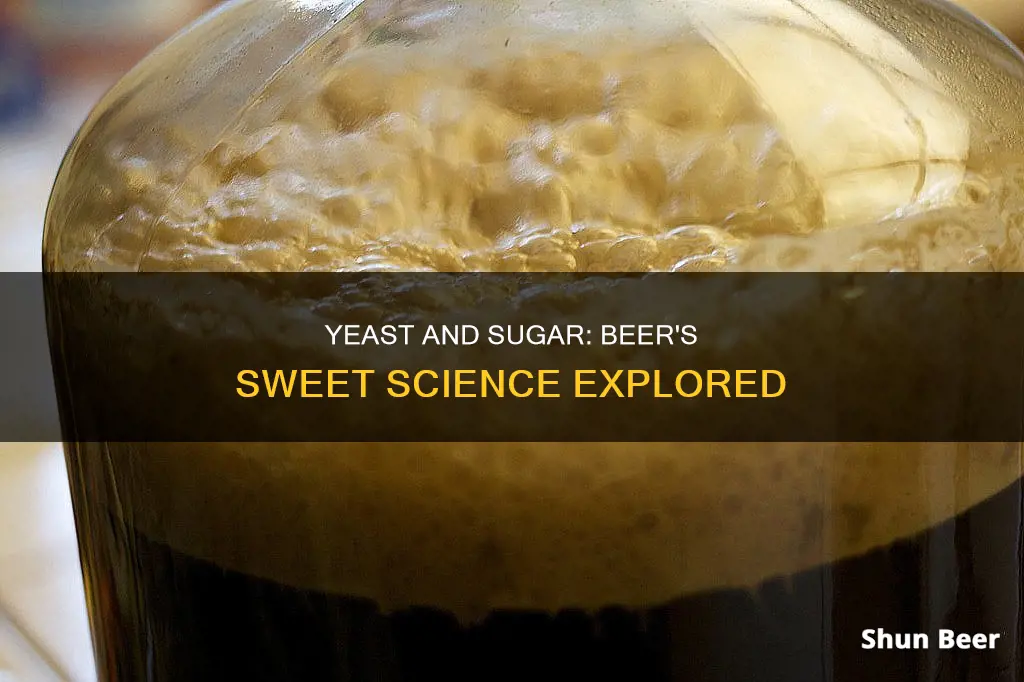
Yeast is a hardy, single-celled fungus that can reproduce sexually and asexually and survive with or without oxygen. It is also the key ingredient in beer, wine, and bread, converting sugar into alcohol. But does yeast die after fermentation? The answer depends on several factors, including temperature and alcohol levels. While yeast can lie dormant for extended periods, it eventually dies when it runs out of sugar to consume. In beer and wine production, yeast becomes dormant once the alcohol level reaches a certain point. However, adding more sugar to the mixture can re-activate the yeast, allowing it to continue the fermentation process and increase the alcohol content.
What You'll Learn

Yeast can be reactivated by adding sugar
Yeast is a hardy, single-celled organism that can survive with or without oxygen. It is hard to kill and can reproduce both sexually and asexually. It can also lie dormant in cooler temperatures or when it cannot find food for a long time.
Yeast survives on sugar, which it consumes and converts to alcohol. Therefore, adding sugar can help reactivate dormant yeast. However, it is important to note that yeast can also be stressed and stagnated by too much sugar, so the amount added is crucial.
In the context of beer brewing, yeast is essential for fermentation. After fermentation, yeast will flocculate and lie dormant, awaiting collection by the brewer for reuse. However, if the yeast is exposed to extreme heat or too much alcohol, it can die.
If you are trying to reactivate yeast in bottled beer, adding priming sugar can help. However, it is important to ensure that the bottles are airtight and that the beer is at room temperature (around 21°C or 70°F) for the yeast to become active again.
Additionally, it is worth noting that yeast can be revived even from old beer bottles. While the viability of the yeast may be lower, it is not entirely dead and can be cultured and reactivated with the right conditions.
Goldberg Beer: Sugar Content and Nutritional Facts
You may want to see also

Yeast dies in extreme heat or high alcohol levels
Yeast is a hardy, single-celled organism that has existed on Earth for millions of years. It is hard to kill but it can die in extreme heat or when exposed to high levels of alcohol.
Yeast survives by consuming sugar and converting it to alcohol. It can reproduce sexually and asexually, and survive with or without oxygen. It can also lie dormant in cooler temperatures or when it cannot find food.
However, yeast does have trouble surviving in extremely hot temperatures and in the presence of too much alcohol. In beer and wine, yeast will usually stop fermenting when the alcohol level reaches a certain point and simply lie dormant. But in the case of fortified wine, for example, additional alcohol can be added, which will kill the yeast.
Similarly, if the alcohol is brought to a boil after fermentation, all the yeast will be killed off as yeast dies at temperatures close to 120 degrees Fahrenheit (48.8 degrees Celsius).
Yeast activity monitoring is essential for optimizing the process of yeast harvesting and repitching.
Draft Beer's Sugar Content: How Sweet is Too Sweet?
You may want to see also

Yeast can lie dormant for a long time
Yeast is a fascinating, complex, and hardy microscopic organism that has been around for almost as long as the first fungus and certainly as long as any natural sugar. It is a single-celled, eukaryotic living organism that can reproduce both sexually and asexually and can survive with or without oxygen. It is also incredibly resilient and can lie dormant for a long time.
Yeast survives on sugar, which is why it can be found virtually everywhere, and its job is to find sugar, consume it, and convert it to alcohol. It is this quality that has made it so valuable to humans, who have been working with yeast for thousands of years.
Yeast will become dormant and eventually die after a few weeks or months, but only after any food sources have been consumed. In the absence of food, yeast can lie dormant in cooler temperatures or when it cannot find food for a long time. It can also be killed by extremely high temperatures or the presence of too much alcohol.
Dried yeast is a commercially available form of yeast that has been harvested and put through a drying process to preserve it. It will stay dormant without dying for up to 2 years and can be reactivated by adding moisture.
Yeast is an incredibly resilient life form that has survived for millions of years. Its ability to lie dormant for extended periods contributes to its longevity.
Beer vs Sugar: Which is the Lesser Evil?
You may want to see also

Yeast reproduces during fermentation
Yeast reproduces both sexually and asexually. During the fermentation process, yeast reproduces asexually by budding. In this process, a small bud (or "bleb" or "daughter cell") forms on the parent cell. The nucleus of the parent cell then divides into two, with one part migrating into the daughter cell.
Yeast reproduces fastest in the presence of oxygen, due to the increased availability of energy stores to meet its metabolic needs. However, yeast can also reproduce anaerobically, which is why it is used in fermentation.
After pitching, yeast enters the "Lag Phase", during which it reproduces as quickly as possible. The key ingredient during this phase is glycogen, a sugar stored internally in the yeast, which is broken down into glucose to fuel reproduction. If there is insufficient yeast pitched, or the yeast is low in glycogen, there will be an excess of diacetyl (resulting in a buttery or butterscotch flavour) in the finished beer.
The lag phase is followed by the respiration (or growth) phase, during which the cells grow logarithmically by cellular division. In this phase, the critical ingredients are oxygen and a variety of yeast nutrients. The cells will continue to grow until the oxygen or nutrients are depleted.
Once the oxygen has been used up, the fermentation phase begins. Yeast cells convert simple sugars into carbon dioxide, alcohol, and beer flavours. As the sugars are consumed, the gravity of the beer will rapidly drop. Fermentation normally takes 3-7 days.
Best Low-Sugar Beers: The Sweetness Spectrum
You may want to see also

Yeast is hard to kill
Yeast is a hardy life form that has been around for almost as long as the first fungus and has survived on Earth for millions of years, outlasting other life forms that have gone extinct. It is hard to kill.
Yeast is a fungus, and the first life form on Earth was a fungus. Yeast can be found everywhere, at all times, in search of sugar. It is a single-celled, eukaryotic living organism that can reproduce both sexually and asexually, and it can survive with or without oxygen. It is also able to lie dormant in cooler temperatures or when it cannot find food for a long time.
The only things that cause trouble for yeast are temperatures that are too hot and the presence of too much alcohol. In addition, yeast is very particular about the temperature of the liquid it is mixed with, working best at temperatures between 70°F and 80°F. If mixed with very hot or boiling liquid, it will be killed, and if mixed with cold liquid, it won't be warm enough to activate.
Yeast survives on sugar, which it converts to alcohol. It can be found in the atmosphere, on every surface, on human skin, and even in the human body.
Yeast will become dormant and eventually die after a few weeks or months, but only after any food sources, like priming sugar, have been consumed.
Beer vs Soda: Which Has More Sugar?
You may want to see also
Frequently asked questions
Yes, you can add sugar to beer after fermentation. However, it is important to note that the yeast will only consume the added sugar if it is still active. If the yeast has died or gone dormant, adding sugar will not restart the fermentation process.
If the yeast is still active, it will consume the added sugar and produce more alcohol and carbon dioxide. This can increase the alcohol content and change the taste of the beer.
The amount of sugar to add depends on the desired alcohol content and taste profile for your beer. However, it is important to note that adding too much sugar can make the beer overly sweet or thin due to the increased ethanol content.
Adding sugar to beer after fermentation can cause several issues. If the yeast is no longer active, the added sugar will not be consumed and can make the beer overly sweet. Additionally, if the yeast is stressed or there is not enough yeast, the added sugar can overwhelm the yeast and cause fermentation issues.







